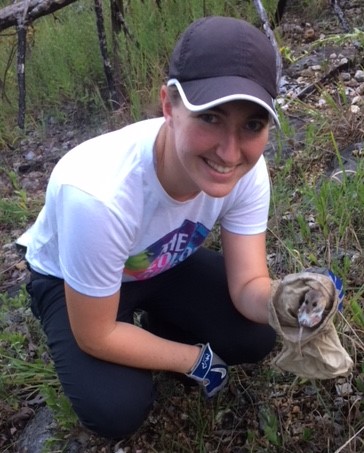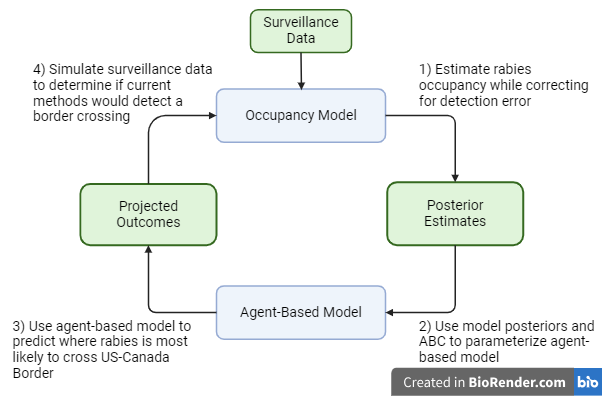Emily Beasley
Welcome to my webpage!

I’m currently a postdoctoral fellow at the Université de Montréal. I’m interested in how ecological processes differ across spatial, temporal, and hierarchical scales. Currently, my work focuses on how landscape structure influences disease dynamics, especially in the context of rabies management.
Feel free to check out the Research and CV tabs for more information.
Research
I use quantitative methods to examine how ecological processes vary across spatial, temporal, and organizational scales; especially in the context of community ecology, disease ecology, and parasitology.
Over the course of my career I’ve also developed an interest in alternatives to p-value significance testing, and how these alternatives can be used to more effectively describe ecological systems. My past research primarily uses Bayesian hierarchical models, but my current work has expanded to other non-frequentist techniques such as agent-based models and network analyses.
Current Projects
Rabies Management in Urban landscapes
Urbanization can affect the transmission and management of zoonotic diseases via changes in host ecology or management strategies. This is particularly true for the raccoon variant of the rabies virus, for which urbanization results in increased population densities of the raccoon hosts and presents challenges for deployment of the oral rabies vaccine (ORV). Predictably, urban areas tend to have vaccination rates that are lower than the threshold thought to prevent rabies outbreaks, leading to a recent outbreak in Burlington, VT.
Despite the current outbreak, Burlington was previously rabies-free from 2017-2022, indicating that characteristics of the urban environment may make rabies elimination possible at lower seroprevalence thresholds. I will explore these ideas by using agent-based models to answer two questions: 1) At what seroprevalence rate is rabies eliminated with a 95% probability over a 10-year preiod? 2) How do varying immigration rates influence time to elimination and probability of invasion? I anticipate that the threshold for local elimination will be less than the 60% previously thought to be required, and that immigration is essential for sustaining rabies outbreaks in urban areas.
Identifying rabies risk corridors using multiple quantitative methods
With increasing raccoon rabies cases close to the US-Canada border, managers in both countries are interested in identifying locations where the virus is most likely to cross the border. Two methods for identifying risk corridors have been independently developed: an enhanced surveillance model using Bayesian methods, and an agent-based model implemented using the Python package SamPy. The surveillance model is built to deal with uncertainty in surveillance data, but has the drawback of being unable to forecast to the future. SamPy, by contrast, is great for forecasting, but there is a great deal of uncertainty in the values for the model parameters.
These methods have complementary strengths, and may be able to generate more accurate predictions if used in tandem. I will use approximate Bayesian computation (ABC) as a method to bridge these two methods (Fig. 1) and more accurately identify possible rabies risk corridors at the US-Canada border.

Publications
Beasley, E.M. & Poisot, T. Vaccination and immigration rates influence raccoon rabies elimination and recolonization in simulated urban-suburban landscapes. In review at Journal of Animal Ecology. Preprint here
Soucy, C.P., Banville, F., Beasley, E.M., Lefebvre, B., Poisot, T., & Cameron, C.B. Modeling the palaeoecological trophic network of the Lower Ordovician Fezouata Shale (Morocco) fossil fauna. In review at Proceedings of the Royal Society B.
Beasley, E.M. Ectoparasite life history traits influence occupancy patterns at varying organizational scales. Journal of Parasitology 110(6): 577-589. pdf GitHub
Beasley, E.M. 2024. Ecologically informed priors improve Bayesian model estimates of species richness and occupancy for undetected species. Ecological Applications 34(2). pdf GitHub
Beasley, E.M., Nelson, K.M., Slate, D., Gilbert, A., Pogmore, F., Chipman, R.B., and Davis, A.J. 2024. The impact of oral rabies vaccination targeting raccoons across a development intensity gradient in Burlington, Vermont, USA, 2015-2017. Journal of Wildlife Diseases 60(1). pdf
Beasley, E.M., Aristizábal, N., Bueno, E.M., & White, E.R. 2022. Spatially explicit models predict coffee rust spread in fragmented landscapes. Landscape Ecology 37:2165–-2178. pdf GitHub
Beasley, E.M. & Maher, S.P. 2019. Small mammal community composition varies among Ozark glades. Journal of Mammalogy 100:1774–1782. pdf GitHub